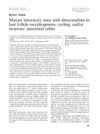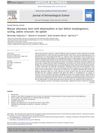Mutant Laboratory Mice With Abnormalities in Hair Follicle Morphogenesis, Cycling, and Structure: An Update
October 2012
in “
Journal of Dermatological Science
”
hair follicle morphogenesis hair follicle cycling hair follicle structure quantitative histomorphometry hair phenotype analysis mouse models spontaneous mutations induced mutations transgenic mice gene alterations hair abnormalities hair follicle dynamics hair growth abnormalities hair development hair structure hair analysis mutant mice genetic mutations hair changes

TLDR The document concludes that mouse models are crucial for studying hair biology and that all mutant mice may have hair growth abnormalities that require detailed analysis to identify.
The document is an updated review from 11 years ago that categorizes mutant laboratory mice with hair growth abnormalities into four groups based on the type of abnormality: morphogenesis, cycling, structure, and extrafollicular events causing secondary abnormalities. It highlights the necessity of quantitative histomorphometry for analyzing hair follicle development and cycling, and discusses common errors in hair phenotype analysis. The review emphasizes the value of mouse models, including those with spontaneous or induced mutations and transgenic mice, for understanding hair biology and pathology. It also provides tables summarizing gene alterations in various mouse mutants and the associated hair abnormalities, noting that changes in hair follicle dynamics may not always be visible and that all mutants should be considered to have a hair phenotype until proven otherwise through detailed analysis.





